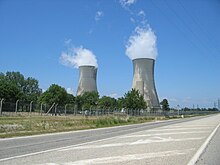Eurodif
You can help expand this article with text translated from the corresponding article in French. (June 2019) Click [show] for important translation instructions.
|
This article needs additional citations for verification. (December 2007) |

Eurodif, which means European Gaseous Diffusion Uranium Enrichment nuclear power station.
light water reactors, a common nuclear power
technology.
History
In 1973
joint stock company EURODIF. Sweden withdrew from the project in 1974. In 1975 Sweden's 10 per cent share in EURODIF was transferred to Iran
as a result of an arrangement between France and Iran. The French government subsidiary company Cogema and the Iranian Government established the Sofidif (Société franco–iranienne pour l'enrichissement de l'uranium par diffusion gazeuse) enterprise with 60 per cent and 40 per cent shares, respectively. In turn, Sofidif acquired a 25 per cent share in EURODIF, through which Iran attained its 10 per cent share of EURODIF.
In 1974, the
Mohammad Reza Shah Pahlavi, Shah of Iran
, lent $1 billion (and another $180 million in 1977) for the construction of the factory, in order to have the right to buy 10% of the production. Iran remains a shareholder of Eurodif via Sofidif. The Franco-Iranian consortium shareholder still owns 25% of Eurodif.
The Georges-Besse plant, named after
EDF
, France's largest electric power company.
Naturally occurring
Areva NC to make the change was the subject of a public discussion in the Rhône-Alpes
region from September 1 to October 22, 2004. The advantage of the new process is that it is more energy efficient: Georges Besse I used the power generated by all three (2,700 MW) of Tricastin's nuclear reactors for uranium enrichment, whereas the new centrifuge-based Georges Besse II plant can make similar amounts of uranium with only 50 MW.
Dismantling
the original Eurodif facility is planned to be completed by the end of 2020.
